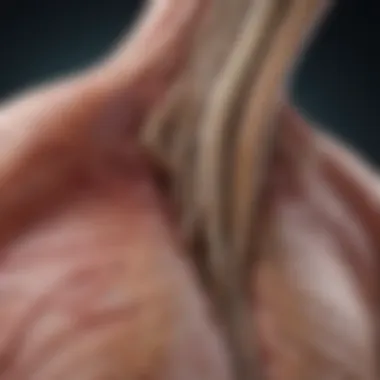Aortic Root Measurements: Essential Insights for Clinicians


Intro
Aortic root measurements play a crucial role in the assessment of cardiovascular health. These measurements are not just numerical figures; they are vital indicators that help in diagnosing and managing various aortic conditions. This article systematically explores the methodologies used, their clinical significance, and the factors that influence these assessments.
An in-depth understanding of aortic root dimensions enhances the capacity of healthcare professionals to determine appropriate management strategies for patients. As we unfold this topic, we will present important findings, analyze existing methodologies, and discuss the relevance of these measurements in both clinical practice and research.
Research Overview
The examination of aortic root dimensions has led to significant insights in cardiology and vascular medicine. Recent studies indicate that precise measurements can predict surgical outcomes and guide therapeutic interventions.
Key findings from the literature include:
- Aortic dilation correlates with increased risk of aortic dissection and aneurysm rupture.
- Variability in measurement techniques can lead to misestimations, affecting treatment decisions.
- Advanced imaging modalities, such as cardiac MRI and 3D echocardiography, provide enhanced accuracy over traditional methods.
Understanding these findings is essential for healthcare professionals. They not only shape clinical practices but also contribute to ongoing research aimed at improving patient care and management strategies.
Methodology
When it comes to aortic root measurements, various techniques have been employed to ensure accuracy and reliability. The methodologies can encompass imaging techniques such as echocardiography, MRI, and CT scans.
Description of Methods
- Echocardiography remains a commonly utilized method due to its non-invasive nature and real-time imaging capabilities. Two-dimensional and three-dimensional modalities enhance the precision of measurements.
- Cardiac MRIs offer a detailed view of the aortic root structure, allowing for comprehensive evaluations.
- CT scans can provide high-resolution images, facilitating the assessment of complex aortic conditions.
Sampling Criteria and Data Collection
Selecting appropriate patients is essential for valid measurement outcomes. Criteria may include age, pre-existing conditions, and clinical indications for measurement. Accurate data collection involves standardized protocols to minimize variability.
Prelude to Aortic Root Measurements
Aortic root measurements are critical in the field of cardiology and vascular medicine. They provide invaluable data regarding the dimensions and functionality of the aortic root, informing the diagnosis and management of various cardiovascular conditions. Accurate measurements can guide clinical decisions, such as identifying the appropriate time for surgical intervention and optimizing patient outcomes.
Definition and Importance
Aortic root measurements refer to the techniques used to assess the size and structure of the aortic root, which connects the heart to the aorta. The significance of these measurements lies in their role in diagnosing conditions like aortic aneurysms, regurgitation, and other abnormalities. Having precise data allows clinicians to evaluate the risk of complications and plan treatment strategies effectively.
Historically, traditional methods have had limitations, including operator dependency and variability in techniques. Modern imaging modalities have emerged to improve the accuracy and reliability of these measurements, making them essential tools in everyday medical practice.
Historical Context
To appreciate the current state of aortic root measurements, it is useful to understand their historical development. Early assessments relied heavily on physical examination and basic imaging techniques, which provided limited insights. As technology progressed, echocardiography became a standard for evaluating cardiac structures, offering a real-time view of heart anatomy.
Advancements in imaging modalities, including cardiac MRI and CT angiography, have further enhanced our understanding of the aortic root. These methods allow for more detailed visualizations and quantitative assessments, reducing ambiguity in measurements. Over the decades, guidelines and recommendations have evolved, reflecting the ongoing research and clinical experiences that shape best practices.
In summary, understanding aortic root measurements is vital for clinicians, researchers, and students. This knowledge underpins many critical decisions in cardiovascular care, demonstrating the interplay between methodical measurement and patient health outcomes.
Anatomy of the Aortic Root
Understanding the anatomy of the aortic root is crucial for both clinicians and researchers in the field of cardiovascular health. This section delves into the structural components and functional roles of the aortic root, providing insights into their significance in various clinical scenarios.
Structural Components
Annulus
The annulus is a fibrous ring that forms the base of the aortic valve and connects it to the left ventricle. This structure allows for the appropriate closure of the valve during diastole. One of the key characteristics of the annulus is its ability to adapt to changes in hemodynamic conditions. By understanding its dimensions, practitioners can better assess various aortic conditions, including aneurysms and regurgitation.
The annulus is considered a beneficial aspect of this overview due to its pivotal role in aortic valve competency. A unique feature of the annulus is its variance in size, which can influence not only the function of the aortic valve but also the overall hemodynamics of the left ventricle. Incorrect measurements can lead to poor surgical outcomes, not highlighting its role in preventing complications.
Aortic Sinuses


The aortic sinuses, at the proximal part of the aorta, facilitate blood flow from the heart into the aorta. These structures play an essential role in supporting normal valve function. A key characteristic of the aortic sinuses is the presence of three distinct cavities, which serve to optimize blood flow and sustain proper closure of the aortic valve. This uniqueness makes it popular in discussions about aortic anatomy and function.
The advantage of studying the aortic sinuses lies in their direct correlation to conditions like aortic stenosis or regurgitation. Being aware of the dimensions of the sinuses provides critical data for the assessment, management, and potential surgical interventions in patients with aortic diseases.
Lateral Walls
The lateral walls of the aortic root are integral to maintaining the structural integrity of the vessel. These walls help accommodate the high-pressure blood flow ejected from the heart. A significant characteristic of the lateral walls is their muscular structure, designed to adapt to varying pressure levels. This component is beneficial since it helps maintain normal aortic function during strenuous physical activity.
The lateral walls offer a unique feature—their ability to remodel in response to pathological conditions such as hypertension. Measuring these walls can provide insights into the aorta's compliance and overall cardiovascular health. Understanding their dimensions contributes to a more comprehensive assessment of aortic conditions, highlighting their importance in clinical evaluations.
Functional Role
The functional aspect of the aortic root is multi-faceted. Primarily, it serves as a conduit for oxygenated blood from the heart to the systemic circulation. Moreover, it plays a critical role in the hemodynamic stability of the cardiovascular system. By providing a flexible yet sturdy support structure, the aortic root helps accommodate variations in blood volume and pressure, which are common during different phases of the cardiac cycle.
Measurement Techniques
Measurement techniques are fundamental in understanding the dimensions of the aortic root. The accuracy of these measurements directly influences diagnosis and treatment plans in clinical settings. Several techniques exist, each with its own set of characteristics, advantages, and limitations. Knowing which technique to use is crucial for obtaining reliable results, impacting patient management and outcomes.
Echocardiography
Echocardiography remains a cornerstone of non-invasive cardiac imaging, particularly in assessing the aortic root. It allows for real-time visualization and measurement of cardiac structures. Two primary types of echocardiography are utilized: transthoracic echocardiography and transesophageal echocardiography.
Transthoracic Echocardiography
Transthoracic echocardiography is a widely used method for evaluating the aortic root. Its non-invasive nature makes it a popular choice. This technique involves placing an ultrasound transducer on the chest to capture heart images. One key characteristic is its accessibility, as it can be performed at the bedside without requiring extensive preparation.
The unique feature of transthoracic echocardiography is the ability to provide real-time data on the heart's functioning. It allows practitioners to visualize the aortic valve and surrounding structures, leading to a comprehensive understanding of aortic conditions. However, one disadvantage is that image quality can be affected by factors like obesity or lung disease, which may hinder accurate measurements.
Transesophageal Echocardiography
Transesophageal echocardiography serves as a complementary technique that provides more detailed images of the aortic root. This method involves inserting a specialized probe into the esophagus to obtain close-up views of cardiac structures. Its key characteristic is the enhanced visualization it offers, especially in patients where transthoracic echocardiography may be limited.
The unique feature of transesophageal echocardiography is its ability to minimize the effects of lung tissue and ribcage that often obscure views in transthoracic echocardiography. While this method provides superior image quality, its invasive nature can lead to discomfort for patients and requires sedation, making it less convenient for some settings.
Cardiac MRI
Cardiac MRI stands out in measuring aortic root dimensions due to its unparalleled precision and lack of ionizing radiation. This technique furnishes detailed images of cardiac anatomy and function. It is particularly useful for assessing aortic aneurysms or other abnormalities that are difficult to evaluate through echocardiography. However, access to cardiac MRI technology can be limited, and it may not be suitable for patients with certain implanted devices.
CT Angiography
CT angiography is another advanced imaging modality used to assess the aortic root. It provides high-resolution images of both the aorta and surrounding vasculature. One of its main advantages is the fast acquisition of images, which is crucial in emergency settings. However, it involves radiation exposure and the need for contrast agents, which may not be appropriate for all patients.
Invasive Measurement Techniques
Invasive measurement techniques, such as catheterization, are primarily utilized when other imaging methods are inconclusive. These methods directly measure the aortic dimensions during surgical procedures or diagnostic evaluations. While they provide highly accurate measurements, the risks associated with invasive procedures must be carefully balanced against their benefits.
Clinical Significance
Understanding the clinical significance of aortic root measurements is crucial for the effective management of patients with aortic conditions. These measurements impact not only the diagnosis but also the treatment protocols used by healthcare professionals. Through accurate assessment, practitioners can identify complications such as aortic dilatation and aneurysms, evaluate the severity of aortic regurgitation, and aid surgical decision-making.
Aortic Dilatation and Aneurysms
Aortic dilatation and aneurysms are serious conditions that require careful monitoring and intervention. The aortic root is the section of the aorta that has the highest likelihood of dilating due to various pathologies. Measurement of the aortic root diameter is essential in evaluating the risk of aneurysm formation. For instance, values greater than 4 cm in adults generally raise concern about potential surgical intervention. Monitoring changes in size over time helps clinicians determine whether the condition is stable or progressive.
In subpopulations like those with connective tissue disorders—such as Marfan syndrome or Ehlers-Danlos syndrome—the thresholds for intervention may differ. Regular imaging and precise measurements are necessary to tailor the management approach for these patients.
Aortic Regurgitation Assessment
In the assessment of aortic regurgitation, accurate measurement of the aortic root is vital. The degree of regurgitation influences the flow dynamics and pressure gradients within the heart. Echocardiographic techniques, including Doppler imaging, can quantify the volume of blood that regurgitates.


By examining changes in aortic root size and morphology, healthcare providers can estimate the severity of regurgitation. For example, a larger aortic root might correlate with an increased volume of regurgitated flow, necessitating closer observation and potential treatment changes. When considering surgical options, such as valve replacement, this information becomes essential for making informed decisions.
Impact on Surgical Decision-Making
Surgical planning greatly depends on precise aortic root measurements. Surgeons assess these metrics to determine the timing and type of surgical procedure necessary. For patients with aortic aneurysms or significant regurgitation, knowing the exact dimensions of the aortic root informs decisions on the appropriate corrective interventions.
Considerations include:
- The use of aortic root replacement or valve-sparing procedures.
- The selection of prosthetic devices that fit the anatomical features of the patient’s aorta.
- The potential risks and complications based on measurement-derived data.
Precise measurements can significantly reduce the risk of postoperative complications, thus enhancing patient outcomes.
Moreover, discrepancies in measurement techniques can lead to varied interpretations and management strategies. Adhering to established measurement protocols and guidelines ensures consistency and accuracy, leading to optimal patient care. Thus, the clinical significance of aortic root measurement extends beyond mere diagnostics; it influences the entirety of patient management strategies.
Factors Influencing Measurements
In the context of aortic root measurements, understanding the various factors that can influence the accuracy and reliability of these metrics is crucial. Multiple elements affect the outcomes, and recognizing these can lead to better diagnostic precision and patient management. This section delves into patient demographics and technical variability, as both play significant roles in shaping the quality of aortic root measurements.
Patient Demographics
Age
The age of a patient significantly contributes to aortic root measurements. As individuals age, anatomical changes occur in the cardiovascular system, including the aortic root. Older adults tend to exhibit a greater diameter of the aortic root, which is an important aspect in evaluating potential aortic diseases.
This characteristic makes age an essential factor to consider when studying aortic root dimensions. The unique feature of age is its clear correlation with the gradual dilatation of the aortic structures. This trend provides critical insights for healthcare providers. Hence, understanding the relationship between age and aortic root measurements is fundamental for accurate assessments and subsequent interventions.
Sex
Sex is another critical demographic factor impacting aortic root measurements. Studies indicate that males typically present with larger aortic root dimensions compared to females. This distinction can have significant implications in clinical scenarios such as diagnosing aortic dilatation.
The key characteristic of sex differences in aortic dimensions is relevant when determining normal ranges and potential pathologies. Additionally, acknowledging the unique features of sex-related variations aids in tailoring individualized patient care. However, a disadvantage of this aspect could be the potential for misdiagnosis if sex is not adequately factored into measurement protocols.
Technical Variability
Operator Technique
Operator technique plays a vital role in the consistency and accuracy of aortic root measurements. Depending on the experience and skill of the operator, results can vary significantly. An adept operator will ensure standardized methods and improved precision, while less experienced individuals may introduce errors.
This aspect underlines the importance of training and skill development for healthcare professionals involved in echocardiography and other imaging modalities. The unique feature of Operator Technique lies in its direct impact on measurement outcomes, illustrating that competence can enhance diagnostic accuracy and reliability.
Equipment Calibration
Equipment calibration is an often-overlooked component influencing aortic root measurements. Properly calibrated equipment ensures that the imaging technology provides accurate data. Failure to calibrate tools can lead to discrepancies in measurement results, compromising patient assessment and possibly leading to inappropriate clinical decisions.
The significance of equipment calibration cannot be understated. Its unique feature is the direct relationship between calibration status and measurement precision. Employing well-calibrated tools can enhance diagnostic confidence but requires regular checks and maintenance, which can be resource-intensive.
"Accurate measurement of the aortic root is not just about technique; it involves a comprehensive approach that includes understanding the demographic context and ensuring reliable imaging tools."
In summary, factors influencing measurements of the aortic root are multi-faceted. Each element, from patient demographics like age and sex to technical considerations such as operator technique and equipment calibration, contributes to the overall reliability of measurement outcomes. Understanding these dynamics will lead to improved clinical practice and patient management.
Measurement Standards and Controversies
In the context of aortic root measurements, the establishment of rigorous measuring standards is critical. These guidelines form the basis of accurate diagnosis and effective treatment strategies. Assessing the aortic root dimensions is vital in various conditions such as aortic aneurysms and regurgitation. Thus, a consensus on measurement protocols enhances comparability of clinical findings and supports the development of tailored patient management plans.
The discussion surrounding measurement standards involves multiple considerations. Such standards must take into account differing techniques and their inherent limitations, potential sources of error, and individual anatomical variability among patients. These factors impact both the reliability and validity of measurements, which in turn influence clinical outcomes.
Current Guidelines
Various medical societies have developed guidelines for measuring aortic root dimensions, emphasizing the necessity for standardization to reduce discrepancies. The American Society of Echocardiography provides specific recommendations on techniques, patient positioning, and angling of ultrasound beams. These protocols typically advise the following aspects:


- Use of two-dimensional echocardiography for routine assessments.
- Measuring the aortic annulus in the parasternal long-axis view.
- Defining sinuses of Valsalva in their maximal diastolic dimensions
The guidelines also delineate the expected dimensions based on demographic factors such as age and sex. Compliance with these guidelines ensures a more uniform understanding of aortic root dimensions within clinical practice.
Debates in Measurement Protocols
Despite existing guidelines, debates persist regarding the most reliable measurement techniques and the interpretation of results. For instance, differences in operator skills and the choice of measurement methods can lead to substantial variability in reported dimensions. Some argue for the superiority of three-dimensional echocardiography over two-dimensional techniques, claiming it offers a more accurate portrayal of aortic anatomy.
Additionally, some researchers question the validity of set normal thresholds for various patient populations, arguing that only by integrating patient-specific factors can more meaningful clinical decisions be made. This leads to ongoing dialogues about whether current protocols adequately address the nuances of aortic anatomy.
"The lack of alignment between imaging modalities and the interpretation of outcomes complicates the diagnostic and therapeutic processes in managing aortic conditions."
Innovations in Aortic Root Imaging
Aortic root imaging has seen significant progress in recent years. These innovations are crucial due to their potential to enhance diagnostic accuracy and patient outcomes. Better imaging techniques lead to improved understanding of aortic conditions. As a result, clinicians can make more informed decisions regarding diagnosis and treatment.
Advancements in Imaging Technology
Recent advancements in imaging technology have transformed the landscape of cardiovascular assessment. Technologies such as advanced echocardiography, cardiac MRI, and CT angiography continually evolve, offering greater precision in measurement.
- Three-dimensional echocardiography provides detailed anatomical views. It allows for better visualization of the aortic root and its components compared to traditional two-dimensional techniques.
- Cardiac MRI has emerged as a critical tool. It offers high-resolution images without exposure to ionizing radiation. This technique excels in assessing soft tissue structures, useful in identifying aortic anomalies.
- CT angiography provides rapid acquisition of images. It serves especially well in emergency settings, helping in assessing aortic dissection or other urgent conditions.
These advancements not only enhance visual quality but also improve the reproducibility of measurements, allowing for higher confidence in clinical assessments.
Emerging Techniques
In addition to current imaging technologies, several emerging techniques hold promise for the future of aortic root imaging. These methods aim to address existing limitations and enhance the overall imaging efficiency.
- Photoacoustic imaging is gaining attention. This technique combines ultrasound and light, capturing detailed vascular information at a microscopic level.
- Artificial intelligence integration into imaging processes shows great potential. AI algorithms can analyze imaging data quickly, aiding in faster diagnoses and assessments.
- Fusion imaging combines modalities such as echocardiography and MRI. It permits cross-referencing information, enriching the analysis of structural heart disease.
The continuous development of these techniques implies a commitment to improving the accuracy and reliability of aortic root measurements. Incorporating these innovative methods into routine clinical practice may lead to better management of aortic-related conditions and ultimately enhance patient care.
Implications on Research and Practice
The study of aortic root measurements holds significant implications for both research and clinical practice. Accurate assessment of aortic root dimensions is paramount for diagnosing various cardiovascular conditions. The relevance transcends basic measurement; it encompasses the understanding of associated risks and guides patient management effectively.
Trends in Research
Current research trends focus on refining measurement techniques to enhance precision. Studies are increasingly looking at the correlation between genetic markers and aortic root dimensions. This could lead to personalized interventions based on individual anatomical variations. Furthermore, advancements in imaging technology are changing the landscape of aortic measurements. Techniques such as three-dimensional echocardiography and advanced cardiac MRI are gaining traction.
- More attention is given to longitudinal studies, monitoring changes in the aortic root over time.
- Research also explores the interplay of hemodynamics and aortic dimensions, leading to better predictive models for aortic diseases.
Ongoing studies aim to establish robust norms for different demographic groups, ensuring that measurements reflect a patient's unique characteristics. These insights can lead to better risk stratification in clinical settings.
Future Directions
Future research directions will likely concentrate on integrating artificial intelligence into imaging techniques. AI could enhance the ability to detect subtle changes in aortic anatomy, leading to timely interventions.
Moreover, there is a growing focus on undertaking multicenter studies to gather comprehensive data across diverse populations. This will help in defining global standards for aortic measurements.
In clinical practice, the implications are profound. Understanding the variability of aortic root geometries can significantly improve surgical outcomes. As we refine methodologies, the potential to predict aortic-related events with greater accuracy will become increasingly viable.
In summary, the implications for research and practice in aortic root measurements are multidimensional. Researchers and practitioners must remain agile and informed to implement the latest findings into routine clinical use.
The End
In the realm of cardiovascular health, understanding aortic root measurements holds significant value. This article has examined how precise measurements influence clinical diagnosis and management of various aortic conditions. Accurate assessments are not just procedural; they directly impact patient outcomes.
Summary of Key Points
Key points discussed in this overview include:
- Definition and Importance: Aortic root measurements are critical for diagnosing conditions like aortic aneurysms and regurgitation.
- Measurement Techniques: Various techniques including echocardiography, cardiac MRI, and CT angiography were explored, each with unique advantages and limitations.
- Clinical Significance: Reliable measurements inform surgical decisions and help assess disease progression.
- Factors Influencing Measurements: Patient demographics and technical variability are crucial in obtaining reliable data.
- Innovations in Imaging: Technological advancements enhance accuracy and offer new methods for assessment.
Final Thoughts
Accurate aortic root measurements are not just numbers; they are a foundation for informed clinical decisions, influencing the trajectory of patient care.







